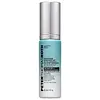What's inside
What's inside
 Key Ingredients
Key Ingredients

 Benefits
Benefits

 Concerns
Concerns

 Ingredients Side-by-side
Ingredients Side-by-side

Water
Skin ConditioningVitis Vinifera Fruit Water
Skin ConditioningGlycerin
HumectantButylene Glycol
HumectantEthylhexyl Palmitate
EmollientPalmitoyl Grape Seed Extract
Skin ConditioningPolyacrylate Crosspolymer-6
Emulsion StabilisingCaprylyl Glycol
EmollientSqualane
EmollientVitis Vinifera Juice
AntioxidantXanthan Gum
EmulsifyingSorbitan Oleate
EmulsifyingSodium Carboxymethyl Beta-Glucan
CleansingCitric Acid
BufferingHyaluronic Acid
HumectantSorbitan Laurate
EmulsifyingSodium Phytate
Sodium Benzoate
MaskingSodium Hydroxide
BufferingDisodium Acetyl Glucosamine Phosphate
Skin ConditioningPotassium Sorbate
PreservativeMyristyl Malate Phosphonic Acid
Skin ConditioningParfum
MaskingWater, Vitis Vinifera Fruit Water, Glycerin, Butylene Glycol, Ethylhexyl Palmitate, Palmitoyl Grape Seed Extract, Polyacrylate Crosspolymer-6, Caprylyl Glycol, Squalane, Vitis Vinifera Juice, Xanthan Gum, Sorbitan Oleate, Sodium Carboxymethyl Beta-Glucan, Citric Acid, Hyaluronic Acid, Sorbitan Laurate, Sodium Phytate, Sodium Benzoate, Sodium Hydroxide, Disodium Acetyl Glucosamine Phosphate, Potassium Sorbate, Myristyl Malate Phosphonic Acid, Parfum
Water
Skin ConditioningRicinus Communis Seed Oil
MaskingButylene Glycol
HumectantIsostearyl Neopentanoate
EmollientGlycerin
HumectantSodium Hyaluronate
HumectantLactic Acid
BufferingSphingolipids
EmollientAcrylates/C10-30 Alkyl Acrylate Crosspolymer
Emulsion StabilisingAmylopectin
Phospholipids
Skin ConditioningCarbomer
Emulsion StabilisingPotassium Sorbate
PreservativeEthylhexylglycerin
Skin ConditioningSodium Hydroxide
BufferingAscorbyl Palmitate
AntioxidantTocopherol
AntioxidantLecithin
EmollientSodium Benzoate
MaskingMalachite Extract
AntioxidantLithothamnion Calcareum Extract
Skin ConditioningSodium Citrate
BufferingPentylene Glycol
Skin ConditioningIsostearyl Alcohol
EmollientXanthan Gum
EmulsifyingHydrogenated Palm Glycerides Citrate
EmollientDimethicone
EmollientCI 42090
Cosmetic ColorantPhenoxyethanol
PreservativeWater, Ricinus Communis Seed Oil, Butylene Glycol, Isostearyl Neopentanoate, Glycerin, Sodium Hyaluronate, Lactic Acid, Sphingolipids, Acrylates/C10-30 Alkyl Acrylate Crosspolymer, Amylopectin, Phospholipids, Carbomer, Potassium Sorbate, Ethylhexylglycerin, Sodium Hydroxide, Ascorbyl Palmitate, Tocopherol, Lecithin, Sodium Benzoate, Malachite Extract, Lithothamnion Calcareum Extract, Sodium Citrate, Pentylene Glycol, Isostearyl Alcohol, Xanthan Gum, Hydrogenated Palm Glycerides Citrate, Dimethicone, CI 42090, Phenoxyethanol
 Reviews
Reviews

Ingredients Explained
These ingredients are found in both products.
Ingredients higher up in an ingredient list are typically present in a larger amount.
Butylene Glycol (or BG) is used within cosmetic products for a few different reasons:
Overall, Butylene Glycol is a safe and well-rounded ingredient that works well with other ingredients.
Though this ingredient works well with most skin types, some people with sensitive skin may experience a reaction such as allergic rashes, closed comedones, or itchiness.
Learn more about Butylene GlycolGlycerin is already naturally found in your skin. It helps moisturize and protect your skin.
A study from 2016 found glycerin to be more effective as a humectant than AHAs and hyaluronic acid.
As a humectant, it helps the skin stay hydrated by pulling moisture to your skin. The low molecular weight of glycerin allows it to pull moisture into the deeper layers of your skin.
Hydrated skin improves your skin barrier; Your skin barrier helps protect against irritants and bacteria.
Glycerin has also been found to have antimicrobial and antiviral properties. Due to these properties, glycerin is often used in wound and burn treatments.
In cosmetics, glycerin is usually derived from plants such as soybean or palm. However, it can also be sourced from animals, such as tallow or animal fat.
This ingredient is organic, colorless, odorless, and non-toxic.
Glycerin is the name for this ingredient in American English. British English uses Glycerol/Glycerine.
Learn more about GlycerinPotassium Sorbate is a preservative used to prevent yeast and mold in products. It is commonly found in both cosmetic and food products.
This ingredient comes from potassium salt derived from sorbic acid. Sorbic acid is a natural antibiotic and effective against fungus.
Both potassium sorbate and sorbic acid can be found in baked goods, cheeses, dried meats, dried fruit, ice cream, pickles, wine, yogurt, and more.
You'll often find this ingredient used with other preservatives.
Learn more about Potassium SorbateSodium Benzoate is a preservative. It's used in both cosmetic and food products to inhibit the growth of mold and bacteria. It is typically produced synthetically.
Both the US FDA and EU Health Committee have approved the use of sodium benzoate. In the US, levels of 0.1% (of the total product) are allowed.
Sodium benzoate works as a preservative by inhibiting the growth of bacteria inside of cells. It prevents the cell from fermenting a type of sugar using an enzyme called phosphofructokinase.
It is the salt of benzoic acid. Foods containing sodium benzoate include soda, salad dressings, condiments, fruit juices, wines, and snack foods.
Studies for using ascorbic acid and sodium benzoate in cosmetics are lacking, especially in skincare routines with multiple steps.
We always recommend speaking with a professional, such as a dermatologist, if you have any concerns.
Learn more about Sodium BenzoateSodium Hydroxide is also known as lye or caustic soda. It is used to adjust the pH of products; many ingredients require a specific pH to be effective.
In small amounts, sodium hydroxide is considered safe to use. However, large amounts may cause chemical burns due to its high alkaline.
Your skin has a natural pH and acid mantle. This acid mantle helps prevent harmful bacteria from breaking through. The acid mantle also helps keep your skin hydrated.
"Alkaline" refers to a high pH level. A low pH level would be considered acidic.
Learn more about Sodium HydroxideWater. It's the most common cosmetic ingredient of all. You'll usually see it at the top of ingredient lists, meaning that it makes up the largest part of the product.
So why is it so popular? Water most often acts as a solvent - this means that it helps dissolve other ingredients into the formulation.
You'll also recognize water as that liquid we all need to stay alive. If you see this, drink a glass of water. Stay hydrated!
Learn more about WaterXanthan gum is used as a stabilizer and thickener within cosmetic products. It helps give products a sticky, thick feeling - preventing them from being too runny.
On the technical side of things, xanthan gum is a polysaccharide - a combination consisting of multiple sugar molecules bonded together.
Xanthan gum is a pretty common and great ingredient. It is a natural, non-toxic, non-irritating ingredient that is also commonly used in food products.
Learn more about Xanthan Gum